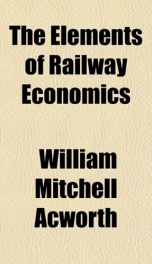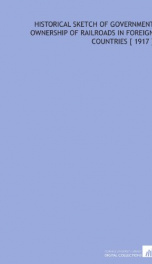the elements of railway economics

Purchase of this book includes free trial access to www.million-books.com where you can read more than a million books for free. This is an OCR edition with typos. Excerpt from book: CHAPTER VI RAILWAY INCOME SOME IMPRACTICABLE METHODS OF CHARGING The foregoing chapters have dealt with the nature of railway undertakings from the point of view both of capital and of revenue expenditure. We have seen that the distinguishing features are, qua capital, its magnitude and its irrecoverable nature ; qua both capital and current expenses, the fact that the money is spent for the establishment and maintenance of the undertaking as a whole, and has but slight connexion with special categories and individual items of traffic. Once we have grasped these fundamental facts, we can promptly get rid of not a few popular fallacies as to the equitable basis of railway rates. Volumes have been written to show that railway rates ought to be based on cost of carriage. For two generations Parliamentary Committees and Royal Commissions have been implored to compel English railways to charge on this basis. Whether it is desirable that railway rates should be so based is a question to which we shall need to recur at a later stage. It is simpler to say at this point that such a basis is impossible, as no one knows, or can know, what the cost of carriage is. To begin with, the phrase itself is ambiguous. Cost of carriage of a particular item may mean the additional cost of carryingthat item ; this is normally so small as to be negligible. It may mean the additional cost plus a fair share of the standing costs of the undertaking. The plus figure is nothing more positive than an arbitrarily estimated proportion of a sum that can only be ascertained very roughly, even by a trained railway statistician with access to all the accounts and returns he chooses to call for. Accountants, if required to go into detail, would differ considerably as to what standing costs were affected by a...
Info about the book
Author:
Series:
Unknown
ASIN:
B002IKL86U
Rating:
3/5 (1)Your rating:
0/5
Languge:
English
Users who have this book
Users who want this book
What readers are saying
What do you think? Write your own comment on this book!
write a commentif you like the elements of railway economics try:
Other books by this author
Do you want to read a book that interests you? It’s EASY!
Create an account and send a request for reading to other users on the Webpage of the book!



